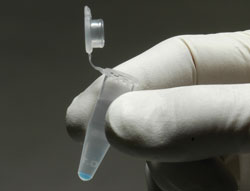Ras Pull-down Activation Assay Biochem Kit (bead pull-down format) - 20 Assays
Product Uses Include
- Analysis of in vivo Ras activation.
Introduction
The Ras switch operates by alternating between an active, GTP-bound state and an inactive, GDP-bound state. Understanding the mechanisms that regulate activation / inactivation of Ras-like GTPases is of obvious biological significance and is a subject of intense investigation. The fact that Ras family effector proteins will specifically recognize the GTP bound form of the protein has been exploited experimentally to develop a powerful affinity purification assay that monitors Ras protein activation. The assay uses the Ras-binding domain (RBD) of the Ras effector kinase Raf1. The Raf-RBD domain has been shown to bind specifically to the GTP-bound form of Ras proteins. The fact that the Raf-RBD has a high affinity for GTP-Ras and that its binding results in a significantly reduced intrinsic and catalytic rate of hydrolysis of Ras make it an ideal tool for affinity purification of GTP-Ras from cell lysates. The Raf-RBD is in the form of a GST fusion protein, which allows one to "pull-down" the Raf-RBD/GTP-Ras complex with glutathione affinity beads. The assay therefore provides a simple means of quantitating Ras activation in cells. The amount of activated Ras is determined by a western blot using a Ras specific antibody.
Kit contents
The kit contains sufficient materials for 20 assays, depending on assay setup, and includes reagents for positive and negative controls. A larger 50 assay version of this kit is available as Cat. # BK008. The following components are included:
- GST tagged Raf1-RBD protein bound to colored glutathione agarose beads (Cat. # RF02).
- p21 Ras monoclonal antibody
- Cell lysis Buffer
- Protease inhibitor cocktail (Cat. # PIC02)
- Wash Buffer
- Loading Buffer
- STOP Buffer
- GTPγS (non-hydrolyzable GTP analog, Cat. # BS01)
- GDP
- Manual with detailed protocols and extensive troubleshooting guide.

Figure 1. The brightly colored glutathione agarose beads in kit BK008-S makes the kit easy to use.
Equipment needed
- SDS-PAGE minigel system and western blotting transfer apparatus
Associated Products:
G-LISA™ Products:
Rac1 G-LISA™ Activation Assay, luminescence format (Cat.# BK126)
Rac1,2,3 G-LISA™ Activation Assay, colorimetric format (Cat.# BK125)
RhoA G-LISA™ Activation Assay, colorimetric format (Cat.# BK124)
RhoA G-LISA™ Activation Assay, luminescence format (Cat.# BK121)
Cdc42 G-LISA™ Activation Assay, colorimetric format (Cat.# BK127)
Associated Products:
Anti-Cdc42 monoclonal antibody (Cat.# ACD03)
Anti-Rac1 monoclonal antibody (Cat.# ARC03)
Anti-RhoA monoclonal antibody (Cat.# ARH03)
For product Datasheets and MSDSs please click on the PDF links below. For additional information, click on the FAQs tab above or contact our Technical Support department at tservice@cytoskeleton.com
Question 1: I have high background and/or multiple bands on my western blot. How can I fix this?
Answer 1: There are multiple causes of high background and/or multiple bands. Some suggestions to improve background signal include:
- When blotting use 70v for 45min only as the small G-proteins are very mobile.
- Fully remove SDS from the gel by using a non-SDS containing buffer for transfer and performing a full 15 min gel wash step in the transfer buffer before blotting.
- Dry the PVDF membrane for 30 min after transfer and before blocking (not necessary for nitrocellulose)
- Making sure that the TBST contains 10 mM Tris, 0.05% Tween 20 and 150 mM NaCl.
- Incubating with the primary antibody overnight at 4°C and using the appropriate ECL detection system.
Question 2: How much of the beads should I use for my pull-down experiments?
Answer 2: Raf-RBD beads (Cat. # RF02) will bind to Ras-GDP with a much lower affinity than Ras-GTP. If too many Raf-RBD beads are added to the pull-down assay there will be significant binding to inactive (GDP-bound) Ras. The result of this will be an underestimation of Ras activation. For this reason, we highly recommend performing a bead titration to determine optimal conditions for any given Ras activation or inactivation assay. Once optimal conditions have been established, bead titrations should no longer be necessary. We recommend 20, 40 and 60 μl (66, 132 and 198 µg) bead titrations.
Question 3: How can I test whether the beads are working properly?
Answer 3: A standard biological assay for Raf-RBD beads consists of a Ras protein pull-down from cells loaded with either GTPγS (Cat. # BS01) or GDP. Here are guidelines to follow (see Cat. # RF02 or BK008 datasheets for more details):
Positive Cellular Protein Control:
Total cell lysate (200 – 500 µg) should be loaded with GTPγS as a positive control for the pull-down assay. The following reaction details how to load endogenous Ras with the nonhydrolysable GTP analog (GTPγS). This is an excellent substrate for Raf-RBD beads and should result in a strong positive signal in a pull-down assay.
a) Perform GTP loading on 200 – 500 μg of cell lysate that is at a protein concentration between 0.4 – 2.0 mg/ml by adding 1/10th volume of Loading Buffer.
b) Immediately add 1/100th volume of GTPγS (200 μM final concentration). Under these conditions, 5 - 10% of the Ras protein will load with non-hydrolysable GTPγS and will be “pulled-down” with the Raf-RBD beads in the assay.
c) Incubate the control sample at 37°C for 30 minutes with gentle rotation.
d) Stop the reaction by transferring the tube to 4°C and adding 1/10th volume of STOP Buffer.
e) Use this sample in a pull-down assay immediately.
Negative Cellular Protein Control:
This reaction should be performed in an identical manner to the Positive Control reaction except that 1/100th volume of GDP (1 mM final concentration) should be added to the reaction in place of the GTPγS. Loading endogenous Ras with GDP will inactivate Ras and this will bind very poorly to Raf-RBD beads.
If you have any questions concerning this product, please contact our Technical Service department at tservice@cytoskeleton.com




